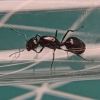- Formiculture.com
- Forums
- Gallery
- Members
- Member Map
- Chat

Eradication of Argentine ants on Santa Cruz Island
Started By
DustyDoes
, Aug 30 2016 2:10 PM
6 replies to this topic
#1
 Offline
-
Posted August 30 2016 - 2:10 PM
Offline
-
Posted August 30 2016 - 2:10 PM
Neat article about conservation efforts on an island in Southern California. I thought it was especially interesting how the conservators are delivering the poisoned sugar water by using rhose little hydrogel polymer beads. Have those been explored by any members here as a means for hydrating or feeding their colonies?
http://www.theverge....ure-conservancy
http://www.theverge....ure-conservancy
#2
 Offline
-
Posted August 30 2016 - 4:00 PM
Offline
-
Posted August 30 2016 - 4:00 PM
I haven't read the article yet—I'll check it out later.
Polyacrylamide/polyacrylate, sometimes sold as "bug gel," is a water-soluble polymer with no nutritive value. Ants can not ingest the polymer itself, and must instead lick the surface. Because the polymer grabs tightly onto water molecules, it releases water too slowly for ants to drink large volumes from the available surface moisture, making it a poor substitute for liquid water in most cases.
The smaller the particles, the faster the water will evaporate out of the polymer, because of the increased surface area. Conversely, large chunks, like those pictured in the article, stay hydrated for longer, because of the smaller exposed surface area compared to volume.
The polymer is highly susceptible to solvents, and readily decomposes in H2O2. If not for that slight problem, it may be an interesting tool to use in maintaining humidity levels within a formicarium. In fact, it is used extensively in agriculture for its water retention and slow release properties.
Edited by drtrmiller, August 30 2016 - 4:01 PM.
byFormica® is the manufacturer of the iconic nectar feeders and Sunburst Ant Nectar.
byFormica ant products always deliver consistent performance, convenience,
and reliability, making them among the most beloved ant foods and kit enjoyed by
ant keeping enthusiasts worldwide. For more information, visit www.byFormica.com.
#3
 Offline
-
Posted September 2 2016 - 7:49 PM
Offline
-
Posted September 2 2016 - 7:49 PM
Interesting. In the article, they describe a plan to saturate the beads with poisoned sugar water and then dump bazillions of them from a helicopter over the ants' territory. Do you think the sugar water will successfully encourage the ants to feed or transport the beads to the nest? we don't know the type of or concentration of poison used, but does this seem plausible, or unlikely to succeed?
Is the polymer's susceptibility to solvents a concern in a use case like this? Is hydrogen peroxide used much in formicariums to cause a problem with the beads use as you described?
Could ants eat jello readily?
Is the polymer's susceptibility to solvents a concern in a use case like this? Is hydrogen peroxide used much in formicariums to cause a problem with the beads use as you described?
Could ants eat jello readily?
#4
 Offline
-
Posted September 3 2016 - 4:42 AM
Offline
-
Posted September 3 2016 - 4:42 AM
Sucrose solutions are certainly used in a number of liquid ant baits. Sunburst Ant Nectar is essentially the same liquid used in ant baits, minus the poison, which is why it is so attractive to many species of ants.
Ant poisons work by delaying the time it takes for the poison to take effect. In this way, the food can be shared with many colony members, and hopefully the queen, so all the ants die.
As to your other questions, the baits were probably intended to distribute the poison quickly, rather than over a long period of time, in the same way that extinguishing a fire with water or foam works on a single fire, but does not prevent future fires. H2O2 is probably not used much in a formicarium, though it is, in my view, the only compound that should be used to eliminate fungi and bacteria.
Ants can not eat jello, as it is too viscous to pass through the buccal tube filter. They can, however, lick any liquid sweat released by gelatin, in the same way as the synthetic polymer gel.
byFormica® is the manufacturer of the iconic nectar feeders and Sunburst Ant Nectar.
byFormica ant products always deliver consistent performance, convenience,
and reliability, making them among the most beloved ant foods and kit enjoyed by
ant keeping enthusiasts worldwide. For more information, visit www.byFormica.com.
#5
 Offline
-
Posted September 19 2016 - 8:33 PM
Offline
-
Posted September 19 2016 - 8:33 PM
Are Argentine ants those small black ants which are pretty fast on the sidewalks and everywhere else?
![]()
![]()
![]()
![]()
Ex igne et in infernum.
#6
 Offline
-
Posted September 20 2016 - 8:08 AM
Offline
-
Posted September 20 2016 - 8:08 AM
Are Argentine ants those small black ants which are pretty fast on the sidewalks and everywhere else?
uh, that is really vague. "Small black ants" refers to tons of ants species. Any ant species can walk on the sidewalk. Not to mention small and fast are completely subjective.
Edited by Mdrogun, September 20 2016 - 8:09 AM.
Currently Keeping:
Trachymyrmex septentrionalis
Pheidole pilifera
Forelius sp. (Monogynous, bicolored) "Midwestern Forelius"
Crematogaster cerasi
Pheidole bicarinata
Aphaenogaster rudis
Camponotus chromaiodes
Formica sp. (microgena species)
Nylanderia cf. arenivega
#7
 Offline
-
Posted September 20 2016 - 2:48 PM
Offline
-
Posted September 20 2016 - 2:48 PM
Since
Are Argentine ants those small black ants which are pretty fast on the sidewalks and everywhere else?
Since the location in this questions is apparently in Santa Monica I would say that the ants in question are indeed Argentines.
1 user(s) are reading this topic
0 members, 1 guests, 0 anonymous users
















